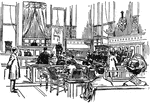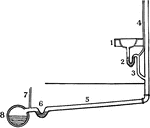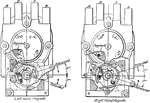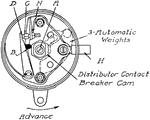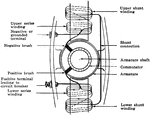!["The Tapeworm is an intestinal worm, Tænia solium, in form somewhat resembling tape. Its length is from 5 to 15 yards, and its breadth from two lines at the narrowest part to four or five at the other or broader extremity. At the narrow end is the head, which is terminated anteriorly by a central rostellum, surrounded by a crown of small recurved hooks, and behind them four suctorial depressions; then follow an immense number of segments, each full of microscopic ova. The segments are capable of being detached when mature, and reproducing the parasite. There is no mouth; but nutrition appears to take place through the tissues of the animal, as algæ derive nourishment from the sea water in which they float. The digestive system consists of two tubes or lateral canals, extending from the anterior to the posterior end of the body, and a transverse canal at the summit of each joint. [Pictured] A, ovum with contained embryo, B, Cystericus longicollis."—(Charles Leonard-Stuart, 1911)](https://etc.usf.edu/clipart/16600/16600/tapeworm4_16600_mth.gif)
Tapeworm
"The Tapeworm is an intestinal worm, Tænia solium, in form somewhat resembling tape. Its length…
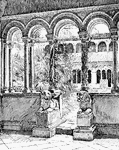
Cloister of the Lateran
"The Benedictine system enjoined three virtues as essential; solitude, humility, and obedience." —…

Abram Stevens Hewitt
Hewitt was a congressman, major of New York City, teacher, iron manufacturer, and lawyer.
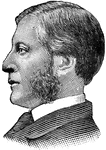
Charles W. Eliot
Educator who became president of Harvard and presided over a period of great growth which included the…

Lymphatic Vessels in the Fingers
"Among the cells of the body there is, besides the blood capillaries, a system of fine, thin-walled…
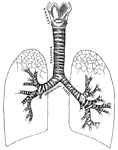
Respiratory system
"Larynx, trachea, and bronchi, showing the manner of division, and the rings of cartilage." —…

Central Nervous System
"Brain and spinal cord, with the thirty-one pairs of spinal nerves." — Tracy, 1888
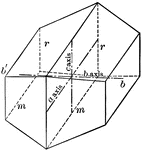
Crystal of the monoclinic system
"A crystal form does not necessarily make a solid figure. One such an example is this, of the Monoclinic…

Symmetry of Sphenoidal class
"The Sphenoidal Class corresponds in the Tetragonal system to the Tetrahedral class in the Isometric…

Symmetry of normal class
"The symmetry of the Normal Class of the Hexagonal System is as follows: The vertical crystallographic…
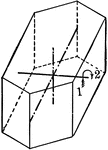
Symmetry of monoclinic system
"The symmetry of the Monoclinic System is as follows: The crystallographic axis b is an axis of binary…
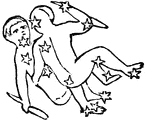
Gemini
"The third sign of the zodiac, so named from its 2 brightest stars, Castor, of the 1st magnitude, farthest…

Snail
"Soft unsegmented bodies, bilaterally symmetrical, enveloped by a leathery mantle, which usually develops…
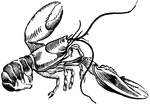
Lobster
"Bilaterally symmetrical bodies composed of a series of rings or segments, each of which bears a pair…

A Dutch Patroon
In the United States, a patroon was a landholder with manorial rights to large tracts of land in the…

Kidney
Two glands having the function of secreting urine from the system, situated at the back of the abdominal…

Druids
"The Druidical system was at the height of at the time of the Roman invasion uner Julius Caesar. Against…

Sympathetic Nervous System
"Part of the sympathetic nervous system seen from in front, n, one of the two chief cords, t, i, and…

Veins
The portal system of veins. a: Portal vein. b: Splenic vein. c: Right gastro-epiploic vein. d: Inferior…

Circulatory
1: Left ventricle of the heart. 2 and 3: Aorta. 5: Arteries that extend to the lower extremities. 6:…

Circulatory
1: Right auricle of the heart. 2 and 3: Large veins that open into the right auricle. 4: Veins of the…
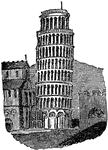
Pisa
A city in Italy, capital of a province of the same name, on the Arno River, forty-four miles west of…
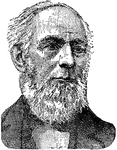
Sir Isaac Pitman
An educator and inventor of the Pitman system of shorthand writing, born in Trowbridge, England, Jan.…

Skeleton
The framework of animals, which in vertebrates is composed of bone and cartilage. It serves to support…
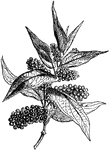
Cubeb
In aromatic warmth and pegency cubebs are far inferior to the pepper; but they are much valued in diseases…

Stenostoma
In this Turbellarian the digestive tract (d.t.) is a blind sac. st., boundary of stomodaeum and mesenteron;…

Blood Circulation
This illustration shows a representation of the circulation of the blood, in its essential features.…

Nephridium
This illustration shows a representation of the circulation of the blood, in its essential features.…

Turbellarian
This is a diagram of transverse section of a Turbellarian through the region of the mouth. d.m., dermo-muscular…
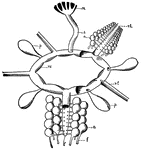
Starfish
This diagram shows a portion of the water-vascular system of the starfish. a, ampullae; f, ambulacral…

Annelid
This diagram shows the longitudinal section of the anterior end of the annelid. A, sagittal section;…

Ignition System
Diagram of a low-tension ignition system. A is the battery, B is a spark coil, and C, D, and E are the…

High-Tension Ignition System
Diagram of a high-tension ignition system. A is the source of current, usually a batter in earlier days,…
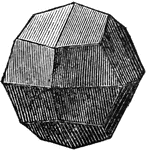
Diploid
A solid belonging to the isometric system, with 24 trapezoidal planes. It is the parallel hemihedral…
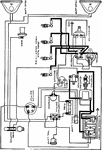
Auto-Lite System
Wiring diagram for auto-lite system on Chevrolet (Royal Mail and Baby Grand Models) showing two-wire…

Jeffery Chesterfield Six
Wiring diagram for Bijur two-wire system on the Jeffery Chesterfield Six (1916 model).

